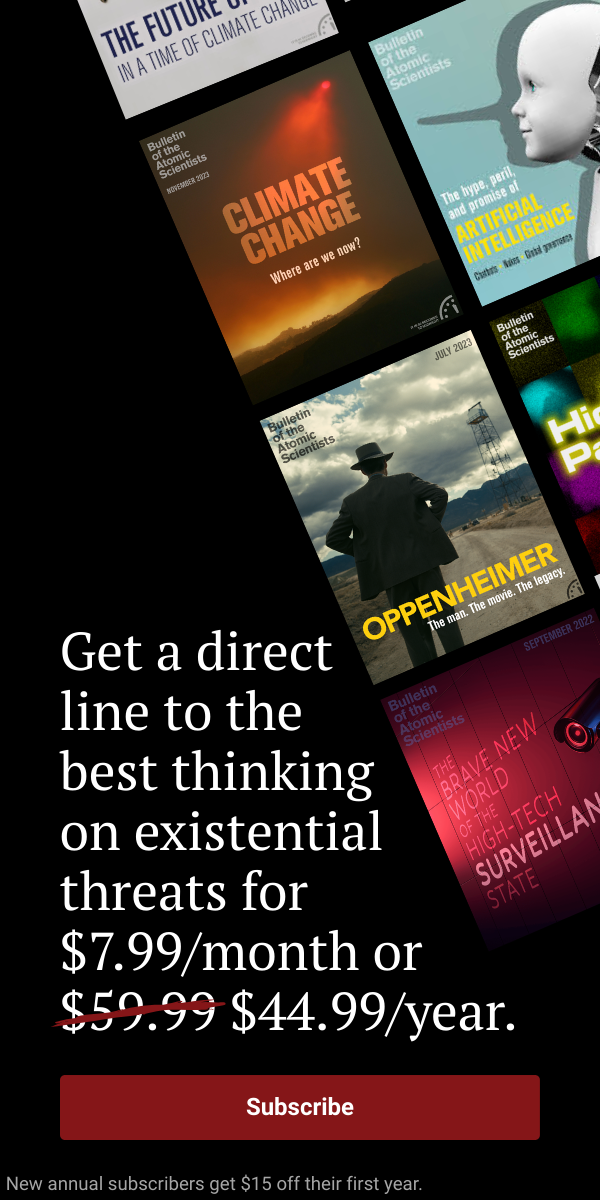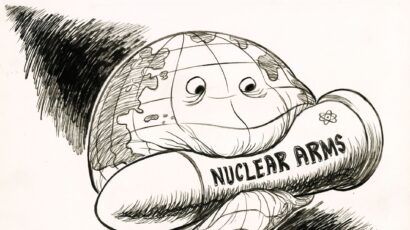How civil society could be the key to a new BWC
By Malcolm Dando | September 22, 2009
People say my office is a mess. While I don’t necessarily disagree with them, I would argue that there is order in the chaos. For example, one pile of papers is labelled “Interesting (All Topics).” I usually reread them during the summer. But making my way through this pile this summer has been difficult because I have spent so much time following the Ashes cricket series and the World Athletics Championships. Lucky then that Jez Littlewood’s appropriately titled paper, “On Your Marks: Thinking about Preparing for the Seventh Review Conference of the Biological Weapons Convention (BWC) in 2011,” came to the top of the pile and refocused my attention–not only on the BWC but also on an important (though sometimes ignored) aspect of the negotiations: the unique role civil society (i.e., private citizens, scholars, and nongovernmental organizations) should play in its development.
“On Your Marks” (the others in an intended three-part series being “Get Set” and “Go”) focuses on the premise that if civil society wants to play a useful role in shaping the outcomes of this crucial review it needs to begin thinking about and openly discussing now what might be possible to achieve. After all, the 2011 Review Conference will determine the next stage in the convention’s evolution, and some hard choices–such as how to deal with the rapid advances in science and technology–will have to be made. It won’t be acceptable simply to agree to another Intersessional Process in 2011.
While the challenge inspection debate is giving me a sense of déja vu, it seems to me that in order for the BWC to move beyond intermittent implementation and circular arguments on verification, civil society must be involved and they must be involved now.”
Littlewood is right, of course, in saying that in order to have any influence on the 2011 agreement, civil society has to play a role in evaluating different ideas and proposals and creating a consensus about what should be done to strengthen the convention in the limited time available at the Review Conference. For anyone who questions whether civil society should play a part in complex negotiations, recall how the agreement on landmines was influenced by the united front of more than 1,000 organizations and individuals.
Fortunately, civil society players wouldn’t be starting from scratch when it comes to the BWC. An October 2006 paper by VERTIC clearly demonstrated approaches that could improve the regime. Littlewood’s “On Your Marks” builds on this by focusing on four topics most people would agree are worth attention and that civil society could aid in resolving: (1) confidence building measures (their comprehensive review and major improvements); (2) the implementation support unit (practical enhancements for its staffing, mandate, and outreach activities); (3) compliance assurance (how States Parties can assure each other of their compliance by various means including a Verification Protocol); (4) and advances in science and technology (implications of the increasing overlap between chemistry and biology).
Littlewood is right in suggesting that civil society needs to address these issues since the individuals that make up this group often have relevant specialist knowledge (e.g., in the fields of microbiology and neuroscience). And in many cases, they can pool this knowledge effectively. He even suggested setting up a BWC wiki “that develops collaborative work from many authors and allows editing or modification of the content by different authors.” If civil society had picked up on this suggestion when Littlewood first proposed it, it already would have come to terms with the feasibility of the technical and political issues related to the various options and would be making proposals to States Parties about those options it had refined. For example, a civil society debate might have come to a view on whether the BWC should have a scientific advisory board and, if so, what form it should take. Unfortunately, that’s not the case; no collaborative work has happened. We–and here I include myself–certainly need to get a move on.
If I understand him correctly, Littlewood thinks there are too many unresolved issues between States Parties for verification to go forward in 2011, even with a new administration in Washington. Inherent in his paper, however, is also the idea that civil society might be able to help develop a consensus (even on a difficult issue such as building States Parties’ confidence in each other’s compliance). On the assumption that ex-government officials are part of civil society, two particular contributions to move the verification conversation forward come to mind.
The first is a 1998 paper by Douglas J. MacEachin, former deputy director for intelligence at the CIA. His paper, “Routine and Challenge: Two Pillars of Verification,” casts a rather different light on verification, which is often thought to be solely about catching violations. Obviously, an offensive biological weapons program involves much more than production capabilities–for example, troop doctrine and training–but presumably those concerned with verification focus on production facilities because they are crucial to an offensive program. MacEachin points out, “Absent a regime for subjecting legitimate activities to a high degree of transparency, the best way for a violator to carry out a covert program would be to bury it–piggy-back it–inside a legitimate program.”
This problem isn’t unique to biological arms control, and, in fact, the solution is common: create a treaty architecture (as the Chemical Weapons Convention, or CWC, does) that requires declaration of all sites and facilities with specified characteristics and audits of these sites by “visits with no treaty right of refusal.” (See “Bringing the Soviet military-industrial complex to life” for a historical reaction to such stipulations.) This would make such sites unsafe for proscribed activities and force a violator to consider moving the activities to undeclared sites. But the very existence of such sites would have to be concealed because the treaty architecture would include the possibility of a challenge visit to undeclared sites. Of course, the violator can, in the end, refuse such a challenge visit, but refusal would only serve to confirm suspicions of noncompliance. In short, as MacEachin carefully noted, “In combination, these mutually supporting visitation provisions seek to create a synergistic force that presents only bad choices to a state wishing to produce biological weapons.”
Opponents of this kind of architecture in a treaty regime–which was, of course, embodied in the failed protocol to the BWC–argue that concealment of proscribed activities is possible. But MacEachin argued that this misses the point. The question is: How confident could a violator be that he would succeed in his concealment efforts? So the objective isn’t to be able to detect each and every possible violation but to present a potential violator with the choice of gambling on his ability to conceal proscribed activities within the treaty regime or staying outside the regime. As MacEachin said, “That carries its own burden, and helps remove some of the ambiguity for planning countermeasures and designing military target options. The rogues have declared themselves.” So if a potential violator remains in the treaty, others can be more confident in that state’s compliance, and if they opt out, other means of dealing with them can be used.
The second article, “The OPCW: Reflecting on the Model,” published in July 2009 is written by Ambassador (Ret.) Donald A. Mahley, who was U.S. special negotiator for chemical and biological arms control issues from April 1999 to September 2002 during the negotiations on the failed verification protocol for the BWC. He focuses on how the Organization for the Prohibition of Chemical Weapons (OPCW) will manage the transition from being predominantly concerned with disarmament–the destruction of the vast stockpiles of declared chemical weapons–to nonproliferation. The CWC is particularly relevant since, like the BWC, it covers mid-spectrum agents such as toxins and bioregulators as well as their homologues.
Mahley believes that nonproliferation would be a wide-ranging concern: “It encompasses not only the possibility of states deciding that a chemical weapons breakout capability is a national requirement . . . but also the threat of subnational actors creating a chemical weapons capability for either domestic or international terrorism.” Furthermore, he argues that the skills required to oversee the destruction of chemical weapons are “different in many ways from the skill set required to examine commercial activities and determine the possibility those facilities might be converted on short notice to chemical weapon production or may even be carrying on chemical weapon production clandestinely.” I believe Mahley is thinking here of new kinds of chemical weapons agents such as mid-spectrum agents, for he adds that the schedules of chemicals listed for verification purposes in the CWC might “need to be modified to reflect . . . changes in technology.”
What I found particularly interesting in Mahley’s paper were his views on challenge inspections. As MacEachin’s article explained, the CWC’s architecture is based on declarations, visits, and challenge inspections. But Mahley notes, “In the 12 years the CWC has been in force, there has never been a challenge inspection requested, let alone conducted.” One of the reasons for this, he points out, is the fear that a challenge inspection would potentially expose other secrets in the inspected state, or damage the OPCW if nothing was discovered.
So Mahley is concerned, in part, with finding ways in which this challenge inspection “pillar” of the verification architecture might be modified to address the political impact of a challenge inspection or even to find a different mechanism for resolving doubts about compliance. In his view, lessening the profile of the challenge inspection might enable the Executive Council to debate “the parameters of a challenge, which could go a long way to alleviating fears, especially among some countries not yet party to the CWC,” who worry that an inspection would allow outside inspectors in under the guise of chemical weapons security. Similar issues have made the BWC protocol negotiations difficult, but there are still lessons to be taken from this debate.
While the challenge inspection debate is giving me a sense of déja vu, it seems to me that in order for the BWC to move beyond intermittent implementation and circular arguments on verification, civil society must be involved and they must be involved now. A few individuals have taken initiative toward this end, but a wider cross-section–particularly practicing scientists who have critical knowledge of changing science and technology–should be brought in to contribute to the debate if the BWC is going to be improved in 2011.
Together, we make the world safer.
The Bulletin elevates expert voices above the noise. But as an independent nonprofit organization, our operations depend on the support of readers like you. Help us continue to deliver quality journalism that holds leaders accountable. Your support of our work at any level is important. In return, we promise our coverage will be understandable, influential, vigilant, solution-oriented, and fair-minded. Together we can make a difference.
Topics: Biosecurity, Columnists















